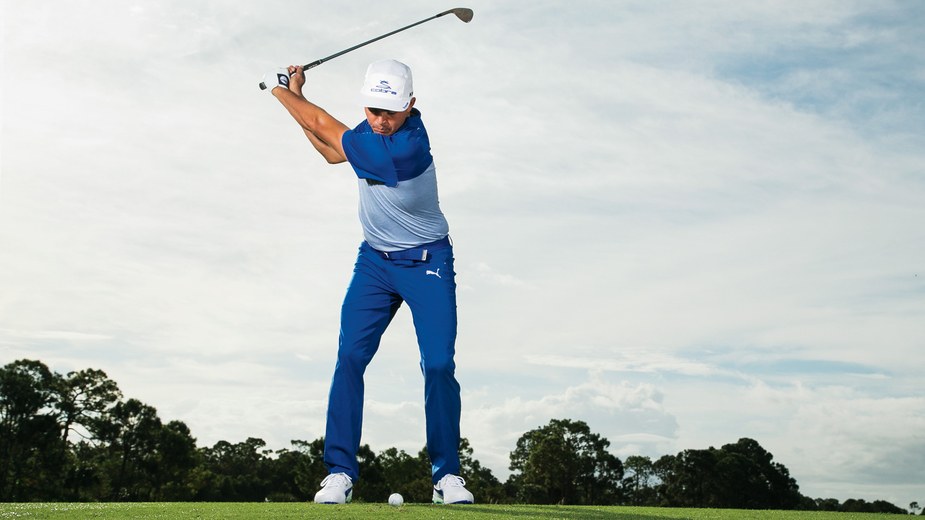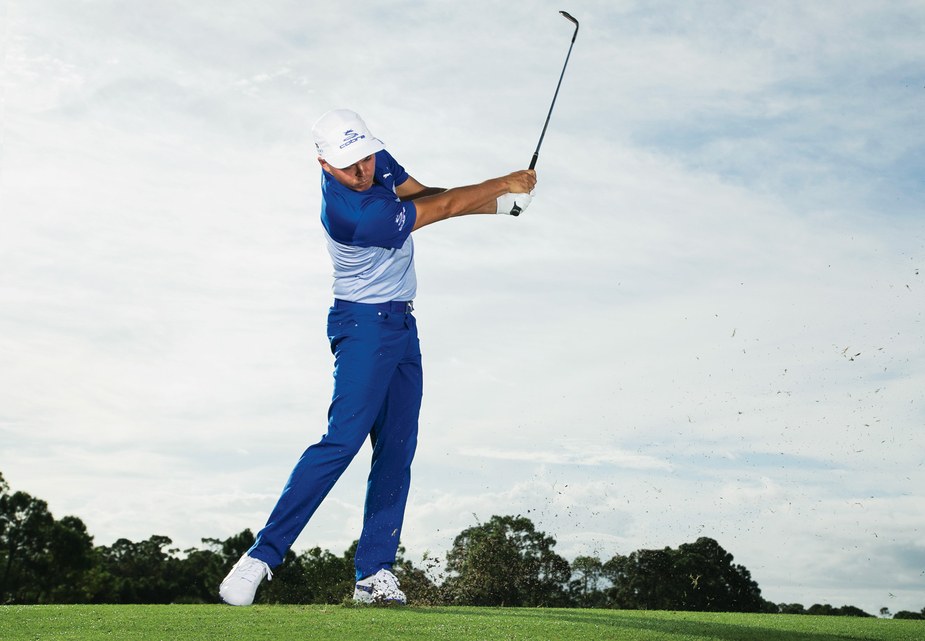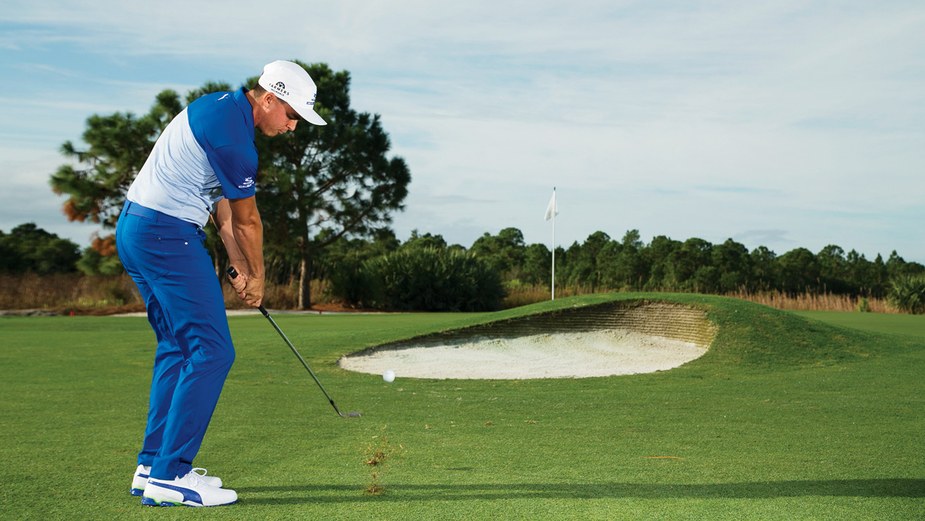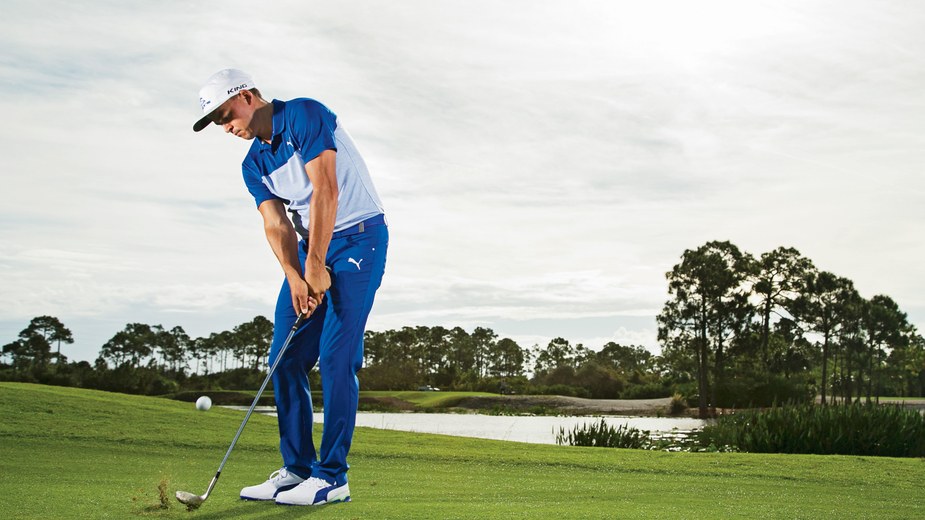Photos by Walter Iooss Jr.
Try my new keys for hitting great wedges
By Rickie Fowler
I already feel a lot more comfortable on the course than I did last year. My priority now is to win a major, and I plan on being in the mix on the big Sundays.
One reason I’m confident is that we have a plan. Butch Harmon and I went through the 2015 stats, and one thing really jumped out: My wedge game was weak. In almost every category the PGA Tour keeps, I was up there—driving the ball long and gaining strokes tee to green and making putts. But from 100 to 125 yards, I finished last year (2015) 145th on tour. On average from that range, I hit the ball 21 feet from the cup. That’s just not good enough. Five or six feet closer, and all of a sudden you’d see a lot more putts go in. Sure, I’d have days where I was throwing it in there tight, but overall, distance control with the wedges cost me.
So, what I give you here is my revamped wedge game. I did a lot of work over the winter getting sharp with three basic shots: the full wedge, a flop-pitch shot and the chip. Master these, and you can cover just about any situation. Slick wedge play makes your on-days great and your off-days still pretty good.
[divider] [/divider]

With wedges, never get loose at the top.’
BACKSWING
Short and Wide
I carry four wedges: pitching, gap, sand and lob. The lofts are 47, 52, 57 and 62 degrees. For me, a full swing with a pitching wedge flies 140 yards, and a full lob wedge goes 90. What all great wedge players can do, of course, is dial up the random “tweener” yardages the course throws their way—121 yards, 107 yards, 84—whatever’s awkward given how far their full wedges carry.
The first step to distance control, Butch says, is matching up the arms with the body. That means your trunk and hands arrive at the top of the backswing at the same time. In this photo, I know I’ve done that because you could draw a line from my chest straight out to my hands. (An unmatched backswing would show my hands out-running my chest and drifting behind me.)
With the longer clubs, like a driver or 5-iron, it’s OK to have a longer backswing. To be free and rhythmical and get more power, you can let your arms go back a little farther after your body stops turning. But with wedges, never get loose at the top. Think short and wide. Your goal is to produce a consistent amount of power, not maximum power.
[divider] [/divider]

Swinging aggressively is the only way to achieve good contact.’
THROUGH-SWING
Turn to the target
Now suppose your full gap wedge goes 110 yards and you’ve got 104 to the hole. To make that wedge fly six yards shorter, a lot of amateurs swing softer. They try to slow down a hair at impact, but that often causes them to hang back and flip their hands. Forget distance control—now they’re lucky if the ball gets in the air. A better method is to set your hands lower on the grip, then swing at normal speed. For me, gripping down an inch takes off five yards. Sometimes I’ll go down the entire length of the grip to take as much as 20 yards off a wedge.
Swinging aggressively is the only way to achieve good contact and to get the ball flying on a predictable trajectory. In this photo, you can tell I’ve fired my hips and chest toward the target with speed. I’m turning through with my big muscles so that my arms and hands feel as if they’re just along for the ride. Like the backswing, I want my follow-through to be abbreviated. Again, check out how my hands are in front of my chest, not lazily drooping over my shoulder.
When I practice, I like to hit to different targets. Mixing it up with each ball simulates what you face on the course: one chance to get it right.
[divider] [/divider]

‘On a scale of 1-10, your grip pressure should be a 1.’
FLOP-PITCH SHOT
Hold the Face Open
Here’s a tough one: a tight lie over sand to a tucked pin, 40 or 50 yards away. It’s too far for a flop, and a basic pitch will scoot to the far side of the green. You need a shot that’s a hybrid. I call it a flop-pitch.
Given the prospects of a poor shot here, it’s natural to be tense. But being tension-free is critical. Start by letting your right arm hang. With the grip resting in the fingers of that hand, let the face fall open so the back of the club lays flush to the ground (above). The leading edge will flare open. Now open your stance a bit.
Finally, set both hands on the club. If you take your grip with the face open, you’re effectively creating a weak grip, which is when both hands are rotated counterclockwise. That’ll help maximize loft at impact. On a scale of 1-10, your grip pressure should be a 1.
I don’t think about the backswing; it’s just a slight turn with a little wrist hinge. My focus is the follow-through. Swing across the ball and along your stance line, and don’t let the hands release (below). Your divot should be shallow, and the face pointing to the sky at the finish.
[divider] [/divider]

‘On a scale of 1-10, your grip pressure should be a 1.’
[divider] [/divider]
BASIC CHIP
Swivel Your Chest
OK, this is not the most exciting shot, but a standard chip saves more strokes than any other shot. And if you can learn to hit it solid, it bleeds into the rest of your game. To start my practice sessions, I begin with little 10-yard chips to hone the feeling of center-face contact.
So here’s a quick refresher on the basics: Take your setup with a bit more weight on the front foot. Some golfers stand open, but I prefer to set up square with a narrow stance. Push your hands just ahead of the ball so the shaft is leaning slightly forward.

The chip is basically an upper-body movement. I don’t want my hips or legs moving much at all. To make this little swing, I feel like a slight swiveling of my chest is the motor that drives the clubhead. The forward angle in my wrists created at address stays fairly constant, but the key is to not be overly stiff during the swing, especially at impact. I see a lot of amateurs tense up and dig the leading edge. With soft wrists, you let the club release past your hands just a tiny bit (above). This activates the bounce, that wide bottom of the clubhead that saves us all from hitting hot screamers and chili-dips.
This article first appeared in 2016.








